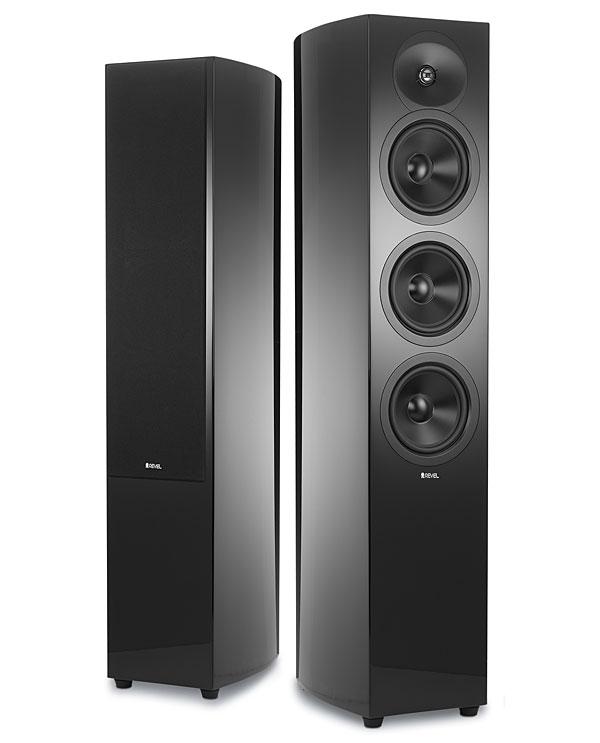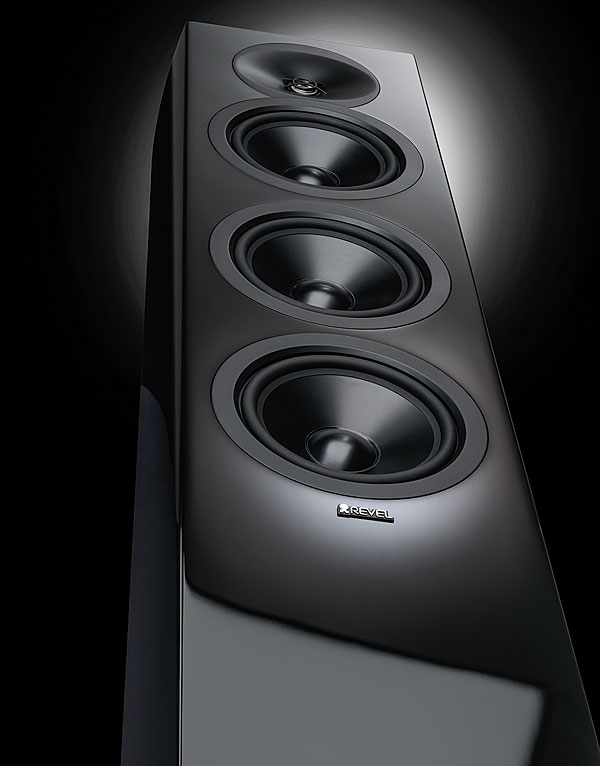Revel Concerta2 F36 Loudspeaker Review

AT A GLANCE
Plus
Superb sound
Punches well above its price
Upscale construction and cosmetics
Minus
A touch more top-end air would be welcome
THE VERDICT
With this impressive redesign of the Concerta line, Revel is more than ready to give its competition sleepless nights.
Revel’s new Concerta2 loudspeaker range consists of five models. The M16 bookshelves, C25 center, S16 surrounds, and B10 subwoofer are covered in a separate review due out shortly. There are also two tower models in the group; the F35 employs three 5-inch woofers, while the larger F36, reviewed alone here, uses three 6.5-inch low-frequency drivers. Apart from the woofer and cabinet sizes, the F35 and F36 are similar in concept.
The original Concertas, introduced in 2005 (Revel speakers tend to remain competitive for a long time), used squared-off, vinyl-veneered cabinets and carried price tags surprisingly low for a company that featured far pricier, high-end models—the upscale Performas and flagship Ultimas. The new F36, like the other Concerta2s, is far more imposing with its curved, glossy piano black or white cabinet finish and a price competitive with the original, allowing for inflation.
 The original Concerta towers and center were full three-way designs. That’s no longer the case; the F36 (and the F35) are 2.5-way. All three of its woofers operate up to about 600 hertz, after which the lower two woofers roll off rapidly using a newly developed (and patent-pending) crossover claimed to provide performance comparable to a full three-way design. The upper woofer continues to operate up to 1.8 kilohertz, where it hands off to the tweeter.
The original Concerta towers and center were full three-way designs. That’s no longer the case; the F36 (and the F35) are 2.5-way. All three of its woofers operate up to about 600 hertz, after which the lower two woofers roll off rapidly using a newly developed (and patent-pending) crossover claimed to provide performance comparable to a full three-way design. The upper woofer continues to operate up to 1.8 kilohertz, where it hands off to the tweeter.
As with other Revel full-range speakers, the F36 employs a waveguide on its tweeter to better match the directivity of the driver handling the midrange. Waveguides also increase the efficiency of the lower range of a tweeter, and when this is scaled back in the crossover to match the efficiency of the rest of the system, the amplifier power the tweeter must contend with is significantly decreased, and therefore, its distortion at a given SPL is lowered. While a downside with some waveguides can be decreased dispersion at higher frequencies, the Concerta2’s newly refined waveguide is also said to improve dispersion above 9 kHz.
All three bass drivers operate into the same cabinet space, with a rear vent refined to minimize port noise. The single set of input terminals (spaced to fit double banana plugs—yay!) is located on the lower rear of the cabinet. The speaker comes with magnetically secured grilles and spikes, though I used neither.
I set up the F36s well out from the wall behind them and about 9 feet apart in my large, open-concept home theater space. They were toed-in to face a listening seat about 10 feet away. My seated ear height was a bit below the tall F36’s tweeter, so I tilted the speakers a few degrees forward. Although my review was focused on the towers, I also did a bit of movie-listening using the original Revel Concerta C12 as a center, S12s as surrounds, and a Revel B15 for subwoofer chores. All in the family,
as it were. The preamp/processor was a Marantz AV8802a, driving three channels of a five-channel Proceed Amp 5 for the front channels and two of the five channels of an Outlaw 750 amplifier for the surrounds (when used). Two Blu-ray players provided the source material: a Marantz UHD7007 for CD music playback from its coaxial digital output and an Oppo UDP-203 player for Blu-ray video sources via HDMI. Neither the Marantz’s Audyssey room correction nor its tone controls were used in any of the listening tests.
Sound
Beginning with two-channel music without the subwoofer, the F36s provided a solid, compelling soundstage. Imaging and depth, when present on the material, were superb, often suggesting that a centered vocalist or instrument were coming from the center speaker when, in fact, it was silent. The sonic perspective was open and fullbodied through the bass and midbass, essentially uncolored in the midrange, and detailed and clear in the treble. I might have preferred a little more air on top, but the overall balance was so convincing that any concerns about this “shortcoming” quickly vanished. No part of the audio spectrum called obvious attention to itself. I simply became immersed in the music, which is as it should be.
While the deepest bass (roughly below 40 Hz) wasn’t particularly powerful, the F36s never sounded lean or thin. In fact, the speaker combined warmth, when required, with low-end punch and clarity where needed—a hard trick to pull off. As I’ve noted before, however, the room is as important as the loudspeaker itself in establishing the bass performance. Most rooms (including mine) seldom offer the best overall bass response from a full-range pair of stereo speakers, no matter how carefully they’re set up. The F36s went a long way to confound this truism. While I had few qualms about the tower when used full range, a good, separate subwoofer or two, properly integrated (not always easy to do, but not the nightmare many audiophiles claim), can often do more to improve the sound than simply extending the bass. Adding the subwoofer to the F36 in my room did make a difference in the deepest bass on some music, but on most, its effect was subtle at best. Slightly higher up the scale, adding the subwoofer did produce a welcome enhancement to the midbass clarity and openness on complex material, but otherwise I had no serious issues with the F36’s midbass without a sub.
I did briefly drive the F36s full range with movies but didn’t push them above –10 decibels (relative to reference level) on the most challenging material. The Revel towers held their own at least to there, but the addition of the subwoofer clearly was needed to really rock my very large room on action flicks—true of all but the largest speakers I’ve reviewed. The F36s are dynamic enough to play as loudly as I wanted in my big room on any music, but I played it a bit safer on movies with powerful bass content (not wanting to blow out a driver and bring the review to a crashing halt). For more average-sized spaces, however, and tastes that don’t run to action movies played at plaster-peeling levels, a subwooferless pair of F36s should fill the bill—at least until you can budget for a subwoofer. (As they say, a day without a sub is like a day without sunshine!) With the sub engaged

in my room, the F36s excelled on movies as varied as Passengers, Oblivion, Sing, The Finest Hours, The Legend of Tarzan, and War Horse. But you might wonder: If you’re crossing over to a sub at 80 Hz, is there any point in going for the Concerta2 towers rather than using the M16 bookshelves? I didn’t have the latter on hand to address this issue (see Mark Fleischmann’s review for an assessment), but it’s improbable that the M16’s single woofer covering the range from 80 Hz to 600 Hz could provide the same dynamic capabilities as the three used in the F36. Make no mistake, music and movies challenge the output of a speaker vastly more in the upper bass and lower midrange than conventional wisdom might lead you to believe. The Concerta2 F35, with its three smaller drivers, might be a good compromise between these two options. Still, some audiophiles who rely on a single system for both music and movies like to shut off their subs with music and just listen to their main left and right speakers full range. That’s another reason they might prefer the F36.
I also briefly compared the F36s with a pair of Monitor Audio Silver 10s, which are somewhat more expensive ($2,750/pair if you choose their optional piano black finish—the latter available standard on the F36). I’m intimately familiar with the Monitor Audios. They offered a bit more clarity through the midrange and treble. This was a plus on detailed, densely scored material but was less forgiving of bright recordings. With their 8-inch woofers (but only two of them), they also sounded more powerful in the low bass than the F36s. The F36s were also more intimate sounding on some material. On a Holly Cole female vocal, for example, the F36s sounded like Cole was singing to me, while the Monitors gave the performance a more analytical slant, with a bit more prominent (but not distracting) sibilance. I love both of these speakers, but for different reasons.
Conclusion
When I told a non-audiophile friend that the $2,000 a pair price tag here was pretty much entry level for a serious floorstanding speaker, he thought it sounded like a huge sum of money, reacting as might anyone who is unfamiliar with today’s audio market. But a bargain these most certainly are: The Revel Concerta2s are clearly aimed at the audio enthusiast. Whether you’re on a budget or are able to spend a lot more, it’s your loss if you don’t have a serious listen to the F36s.






























































